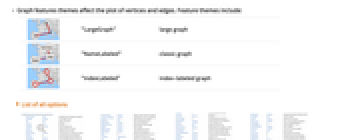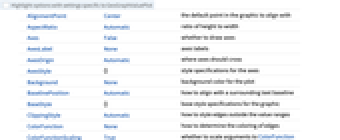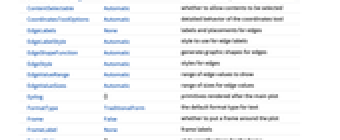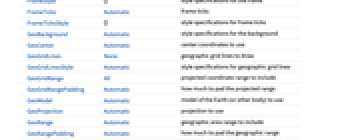GeoGraphValuePlot[{{src1,dest1,flow1},{src2,dest2,flow2},…,{srcn,destn,flown}}]
plots the flows between geo locations.
GeoGraphValuePlot[{{e1,val1},{e2,val2},…}]
plots the values vali for the edges ei.
plots the flow for a graph g with associated edge weights.




GeoGraphValuePlot
GeoGraphValuePlot[{{src1,dest1,flow1},{src2,dest2,flow2},…,{srcn,destn,flown}}]
plots the flows between geo locations.
GeoGraphValuePlot[{{e1,val1},{e2,val2},…}]
plots the values vali for the edges ei.
plots the flow for a graph g with associated edge weights.
Details and Options










- GeoGraphValuePlot is also known as a flow map, distributive flow lines, origin-destination flow maps and thematic map.
- GeoGraphValuePlot is used to show the flow of entities such as goods and people between various locations on the Earth by styling the edges in a graph according to the relative sizes of the flows.
- An undirected edge ei between vertices u and v can be given as uv, u<->v, UndirectedEdge[u,v] or TwoWayRule[u,v]. The character can be entered as
 ue
ue .
. - A directed edge ei from u to v can be given as uv, u->v, DirectedEdge[u,v] or Rule[u,v]. The character can be entered as
 de
de .
. - The geo locations srci and desti can be given in the following forms:
-
GeoPosition[{lat,lon}] latitude and longitude Entity[…] geographic entity Dated[ent,date] dated entity Image[…] geo-tagged image - The graph g can be any edge-weighted graph with geographic vertices.
- The option VertexCoordinates can be used to specify geo locations for vertices that do not already contain them, using the same forms to represent geo locations.
- The values vali can be given in the following forms:
-
vali positive number Quantity[vali,unit] magnitude with units - Data not given in these forms is omitted from the plot.
- The following special wrappers can be used for vertices and edges:
-
Annotation[a,label] provide an annotation Button[a,action] define an action to execute when the element is clicked EventHandler[a,…] define a general event handler for the element Hyperlink[a,uri] make the element act as a hyperlink Labeled[a,…] display the element with labeling PopupWindow[a,cont] attach a popup window to the element StatusArea[a,label] display in the status area when the element is moused over Style[a,opts] show the element using the specified styles Tooltip[a,label] attach an arbitrary tooltip to the element - GeoGraphValuePlot takes the same options as GeoGraphics, with the following additions and changes: [List of all options]
-
ClippingStyle Automatic how to style edges outside the value ranges ColorFunction None how to determine the coloring of edges ColorFunctionScaling True whether to scale arguments to ColorFunction EdgeLabels None labels and placements for edges EdgeLabelStyle Automatic style to use for edge labels EdgeShapeFunction Automatic generate graphic shapes for edges EdgeStyle Automatic styles for edges EdgeValueRange Automatic range of edge values to show EdgeValueSizes Automatic range of sizes for edge values GraphHighlight {} vertices and edges to highlight GraphHighlightStyle Automatic style for highlight GraphLayout Automatic how to lay out vertices and edges Method Automatic method to use MinPointSeparation Automatic when to combine nearby vertices MissingStyle None how to display edges with no weights PerformanceGoal Automatic aspects of performance to try to optimize PlotStyle Automatic graphics directives to determine styles PlotTheme Automatic overall theme for the graph ScalingFunctions None how to scale values TargetUnits Automatic units to use for values VertexCoordinates Automatic coordinates for vertices VertexLabels None labels and placements for vertices VertexLabelStyle Automatic style to use for vertex labels VertexShape Automatic graphic shape for vertices VertexShapeFunction Automatic generate graphic shapes for vertices VertexSize Automatic size of vertices VertexStyle Automatic styles for vertices - EdgeValueRange specifies what range of edge flows to include in the plot.
- The following settings can be given for for EdgeValueRange:
-
All include all edges Automatic automatically select the edges to include {min,max} include edges with weights between min and max - Edges whose sizes are outside the value range are displayed using ClippingStyle.
- EdgeValueSizes specifies the range of thicknesses used to display the edge flows.
- The following settings can be given for EdgeValueSizes:
-
Automatic determine edge sizes automatically Large,Medium,Small,Tiny use preset edge sizes {smin,smax} use minimum size smin and maximum size smax smax use maximum size smax None use the same size for all edges - With the default setting MissingStyleNone, edges without a numeric weight are omitted from the plot.
- ScalingFunctionsscale is used to scale the edge weights. Possible settings for scale include:
-
None use linear scaling "Log" use logarithmic scaling "Reciprocal" use reciprocal scaling {f,f-1} use function f and inverse function 
- GraphLayout specifies where to draw the edges connecting geographic locations.
- Possible settings for GraphLayout include:
-

Automatic automatically compute edges 
"StraightLine" use straight lines as edges 
"Geodesic" use geodesics as edges 
"Rhumb" use rhumb lines as edges 
"Driving","Walking","Cycling" transportation methods - By default, the edges generated by GeoGraphValuePlot are abstract paths, showing self-loops and multiple edges between two vertices when present in the graph.
- If a travel path cannot be found between two vertices, the edge will use "StraightLine" instead.
- EdgeShapeFunctionfunc specifies that each vertex should be rendered with the primitives provided by func[{pt1,pt2},vw], where pt1 and pt2 are the geographic locations of the vertices for the edge vw.
- VertexLabelsAutomatic automatically labels vertices that are named locations. Vertices that are specified using latitude and longitude are left unlabeled.
- Graph features themes affect the plot of vertices and edges. Feature themes include:
-

"LargeGraph" large graph 
"NameLabeled" classic graph 
"IndexLabeled" index-labeled graph -
AlignmentPoint Center the default point in the graphic to align with AspectRatio Automatic ratio of height to width Axes False whether to draw axes AxesLabel None axes labels AxesOrigin Automatic where axes should cross AxesStyle {} style specifications for the axes Background None background color for the plot BaselinePosition Automatic how to align with a surrounding text baseline BaseStyle {} base style specifications for the graphic ClippingStyle Automatic how to style edges outside the value ranges ColorFunction None how to determine the coloring of edges ColorFunctionScaling True whether to scale arguments to ColorFunction ContentSelectable Automatic whether to allow contents to be selected CoordinatesToolOptions Automatic detailed behavior of the coordinates tool EdgeLabels None labels and placements for edges EdgeLabelStyle Automatic style to use for edge labels EdgeShapeFunction Automatic generate graphic shapes for edges EdgeStyle Automatic styles for edges EdgeValueRange Automatic range of edge values to show EdgeValueSizes Automatic range of sizes for edge values Epilog {} primitives rendered after the main plot FormatType TraditionalForm the default format type for text Frame False whether to put a frame around the plot FrameLabel None frame labels FrameStyle {} style specifications for the frame FrameTicks Automatic frame ticks FrameTicksStyle {} style specifications for frame ticks GeoBackground Automatic style specifications for the background GeoCenter Automatic center coordinates to use GeoGridLines None geographic grid lines to draw GeoGridLinesStyle Automatic style specifications for geographic grid lines GeoGridRange All projected coordinate range to include GeoGridRangePadding Automatic how much to pad the projected range GeoModel Automatic model of the Earth (or other body) to use GeoProjection Automatic projection to use GeoRange Automatic geographic area range to include GeoRangePadding Automatic how much to pad the geographic range GeoResolution Automatic average distance between background pixels GeoScaleBar None scale bar to display GeoServer Automatic specification of a tile server GeoZoomLevel Automatic zoom to use for geographic background GraphHighlight {} vertices and edges to highlight GraphHighlightStyle Automatic style for highlight GraphLayout Automatic how to lay out vertices and edges GridLines None grid lines to draw GridLinesStyle {} style specifications for grid lines ImageMargins 0. the margins to leave around the graphic ImagePadding All what extra padding to allow for labels etc. ImageSize Automatic the absolute size at which to render the graphic LabelStyle {} style specifications for labels MetaInformation {} meta-information about the map Method Automatic method to use MinPointSeparation Automatic when to combine nearby vertices MissingStyle None how to display edges with no weights PerformanceGoal Automatic aspects of performance to try to optimize PlotLabel None an overall label for the plot PlotRange All range of values to include PlotRangeClipping False whether to clip at the plot range PlotRangePadding Automatic how much to pad the range of values PlotRegion Automatic the final display region to be filled PlotStyle Automatic graphics directives to determine styles PlotTheme Automatic overall theme for the graph PreserveImageOptions Automatic whether to preserve image options when displaying new versions of the same graphic Prolog {} primitives rendered before the main plot RasterSize Automatic raster dimensions for the background data RotateLabel True whether to rotate y labels on the frame ScalingFunctions None how to scale values TargetUnits Automatic units to use for values Ticks Automatic axes ticks TicksStyle {} style specifications for axes ticks VertexCoordinates Automatic coordinates for vertices VertexLabels None labels and placements for vertices VertexLabelStyle Automatic style to use for vertex labels VertexShape Automatic graphic shape for vertices VertexShapeFunction Automatic generate graphic shapes for vertices VertexSize Automatic size of vertices VertexStyle Automatic styles for vertices

List of all options




Examples
open all close allBasic Examples (2)
Scope (31)
Data (5)
Use geo entities as the vertices in a flow graph:
Use geo locations as the vertices in a graph:
Plot an undirected flow graph:
Use geo-tagged images as graph vertices:
Use VertexCoordinates to position vertices:
Labeling (4)
Use Labeled to label a particular edge flow:
Use Labeled to label a specific vertex:
Use VertexLabels to label a specific vertex:
Edge and Vertex Wrappers (4)
Give colors for specific vertices:
Specify colors for specific flow edges:
Attach a Hyperlink to a specific flow edge:
Graph Styling (18)
Set the style for all vertex labels:
Specify the style for individual vertices:
Draw vertices using a predefined vertex function:
Specify a vertex function for an individual vertex:
Draw vertices by running a program:
Plot an undirected flow graph:
Specify a GraphLayout:
Use a satellite map for the background:
Use the Bonne projection for the map:
Use GeoRangePaddingNone to remove padding:
Use 350 kilometers of padding on each side of the map:
Specify the spacing between them:
Specify parallel and meridians rendering:
Show a color legend when the sizes of flows are None:
Options (54)
AspectRatio (3)
By default, the ratio of the height to the width for the plot is determined based on values:
Make the height the same as the width with AspectRatio1:
AspectRatioFull adjusts the height and width to tightly fit inside other constructs:
Axes (4)
By default, axes are not drawn for GeoGraphPlot:
Use AxesTrue to turn on axes:
Use AxesOrigin to specify where the axes intersect:
AxesStyle (4)
EdgeWeight (2)
EdgeValueSizes (4)
GeoRangePadding (2)
MinPointSeparation (2)
PlotLegends (2)
VertexCoordinates (2)
Use VertexCoordinates to locate vertices:
Use VertexCoordinates to specify the location of a vertex:
VertexLabelStyle (2)
VertexShapeFunction (3)
Applications (4)
Display the import partners for the largest world economies:
Show the number of flights in the USA during 2018:
Plot the total migration flow greater than 100,000 people around the world:
Show Minard's visualization of the successive losses of the French Army during the Russian Campaign between 1812 and 1813:
Properties & Relations (9)
Use GeoGraphPlot to plot relationships between geographic locations on a map:
Use GeoBubbleChart to show values with scaled bubbles:
Use GeoRegionValuePlot to show values with colored regions:
Use GeoListPlot to show the locations of geographic locations and entities:
Use GeoHistogram to aggregate locations into bins:
Use GeoSmoothHistogram to generate smooth densities from locations:
Use GeoVectorPlot and GeoStreamPlot for vector fields:
Draw contours on a map with GeoContourPlot:
Smoothly shade a map using color with GeoDensityPlot:
Related Guides
History
Text
Wolfram Research (2021), GeoGraphValuePlot, Wolfram Language function, https://reference.wolfram.com/language/ref/GeoGraphValuePlot.html.
CMS
Wolfram Language. 2021. "GeoGraphValuePlot." Wolfram Language & System Documentation Center. Wolfram Research. https://reference.wolfram.com/language/ref/GeoGraphValuePlot.html.
APA
Wolfram Language. (2021). GeoGraphValuePlot. Wolfram Language & System Documentation Center. Retrieved from https://reference.wolfram.com/language/ref/GeoGraphValuePlot.html
BibTeX
@misc{reference.wolfram_2025_geographvalueplot, author="Wolfram Research", title="{GeoGraphValuePlot}", year="2021", howpublished="\url{https://reference.wolfram.com/language/ref/GeoGraphValuePlot.html}", note=[Accessed: 19-December-2025]}
BibLaTeX
@online{reference.wolfram_2025_geographvalueplot, organization={Wolfram Research}, title={GeoGraphValuePlot}, year={2021}, url={https://reference.wolfram.com/language/ref/GeoGraphValuePlot.html}, note=[Accessed: 19-December-2025]}